Webinar Summary- After The Blast: Measuring Blast Performance with Drones and AI
We all know blasting performance has a huge downstream impact for loading, hauling, crushing and processing. However controlling this performance has traditionally been limited by the difficulty of conducting regular post-blast assessments.
Until now.
Now, new technologies like drones and artificial intelligence have now made it fast, safe, and easy to measure and analyze every shot. Increase efficiency and decrease total site costs in everyday operations.
Blasting experts Brad Gyngell (Strayos COO) and Jon Lewis (Senior Manager Drill & Blast) discuss how and why everyone should implement drone and AI technologies to streamline post-blast assessment and optimize blast performance so you can
? Optimize Fragmentation
? Tailor your Muck Pile Shape for your Loading Equipment
? Use Automated Cast Optimization
Read on for a summary of the webinar... If you would rather watch the webinar click here.
Our Wonderful Audience!
We had almost 300 Registrants of which 100 attended with fantastic worldwide representation: Sri Lanka, Poland, USA, Bulgaria, Phillipines, Switzerland, India, Indonesia, Mali, Ghana, Turkey, Sudan, Australia, France, Peru, Vietnam, Malaysia, Mongolia.
We had great poll participation and learned some interesting things:
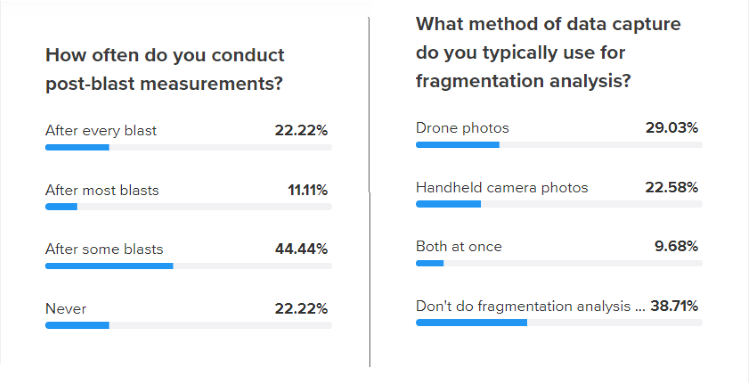
Digging In...
Why Use a Mine to Mill AI System?

Strayos collects data at all stages of the mining process, from surveying to stockpiles. Being able to break down operational data silos gives huge advantages to site owners, managers, and operators. With Strayos AI, information on drill patterns can be correlated with mill performance, geology with muckpile dig-ability. This data lake allows you to see how variables in one part of site operations can have effects elsewhere and enables you to make informed business decisions to optimize overall site performance.
With AI the data collection and visualization is automated saving many hours of tedious manual labor. Once the AI has identified patterns in the data, it can make predictions allowing you to adjust your plans instantly to get the desired results.
The data is pooled in a single location allowing you to see data for every stage of your operations in one place and effectively track it. Best of all its cloud based so any team member can access and collaborate on the project from anywhere (based on the permissions you set-up).
Why Conducting Post-Blast Assessments is Important

Blasting is the cheapest way to break and move rock. Insufficient investment in Drill & Blast operations leads to significant investment elsewhere, whether its loading, hauling, crushing, or waste. There is a sweet spot, where with just a minimal additional investment in Drill & Blast Operations you can reap total operational savings.
While everyone wants to operate at the optimum point, few actually do and without measuring your blasting results you can't know where you fall.
If you dont measure your post blast results, you don't know where you fall on the curve, so you dont know which direction to go, and you don't know how much money is being left on the pit floor.
Traditionally, measuring blast performance has been difficult for 2 reasons
- Logistical- Measuring interrupted operations. You don't want to delay or interrupt loading to resurvey muck piles
- Specialist Expertise- Analysis required specialists who would perform manual muckpile sections and measurements in CAD software. Third Party fragmentation software from 3rd parties that isn't integrated with other software like blast design. Led to outsourcing this analysis.
Now, drones and AI have made post-blast analysis possible for everyone
- Surveying can be done without disrupting operations- the drone just flies above the machines and the muckpile as soon as the dust clears. A few minutes later you have your survey data. Can be done as often as necessary.
- Analysis can be done automatically with AI no expertise required anymore. Now you just click a box.
- Future blasts can be optimized using captured data. The AI can analyze a huge variety of variables and identify patterns in past blasts to make predictions for better future blasts.
2 Examples of how sites that analyze blast results see improvements in production rates and cost efficiency
- Improved muckpile shape
- increases dig rate
- reduces wear on loading equipment
- improves safety of loading operations
- Improved fragmentation
- increases plant throughput
- reduces wear on liner and grinding media
- improves yield and recovery
3 Use Cases for Post Blast Analysis
-
Fragmentation Optimization- Achieving a particle size distribution closer to the feed requirements of the plant.
-
Muckpile Shaping- Matching the muckpile shape to the optimum specification of the digging equipment.
-
Cast Improvement- Throwing more Material into the final spoil position to reduce material handling.
Fragmentation Optimization
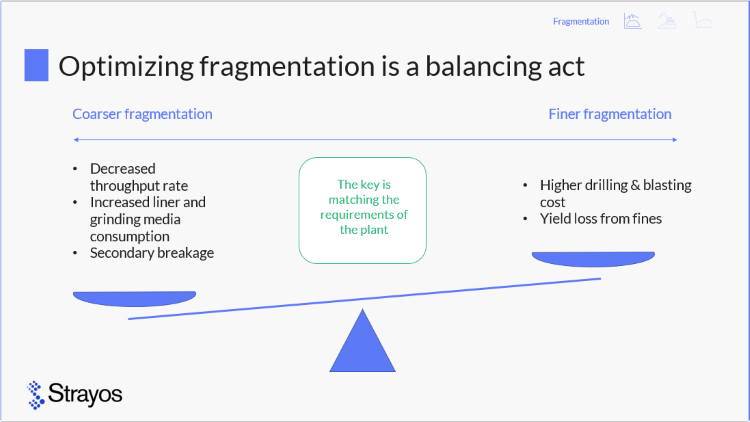
Not rocket science here. Fragmentation that is too big slows down the plant, increases wear on machines and electricity costs for additional grinding, secondary breakage requiress more time, operational slow down, and additional materials, sometimes oversize can be so large its not worth breaking, then you loose product.
Fragmentation that's too small means lost product in fines and higher drilling and blasting costs because you're probably drilling too many holes or using too much explosive.
Fragmentation Size Distribution Should Match the Optimal Feed Distribution of the Crusher
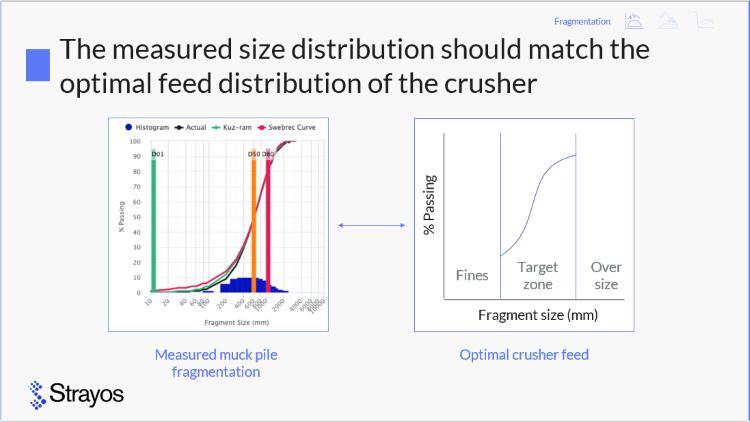
So what you need to do is determine what your current size distribution is and then running a continuous improvement cycle to adjust drill and blast parameters, measure changes and work towards where the two distributions match each other as close as possible.
Easy in theory, harder in real life. To overcome this, you need to be able to quickly collect data, store that data in a way that allows assessment over time, and link it back to the pre-blast data.
Drones and AI Have Made Fragmentation Measurement Faster and Safer
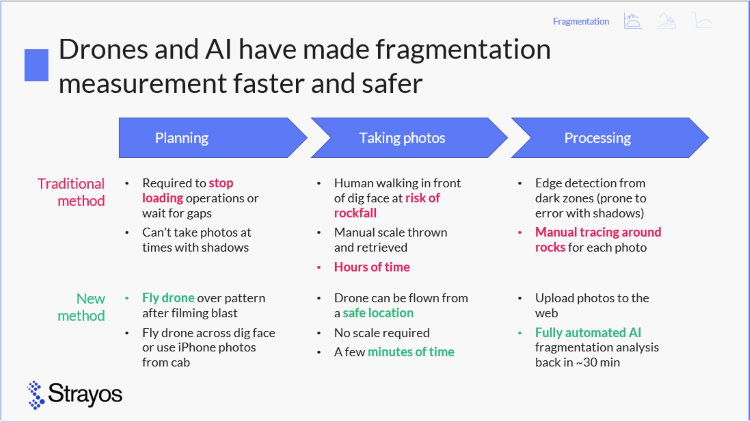
Loader mounted cameras also make fragmentation measurement faster and safer.
Muckpile Shaping
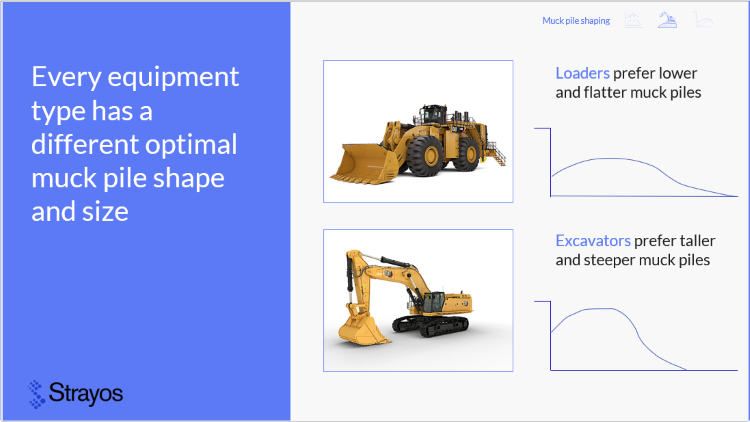
Get the muckpile that's best for the loaders you have
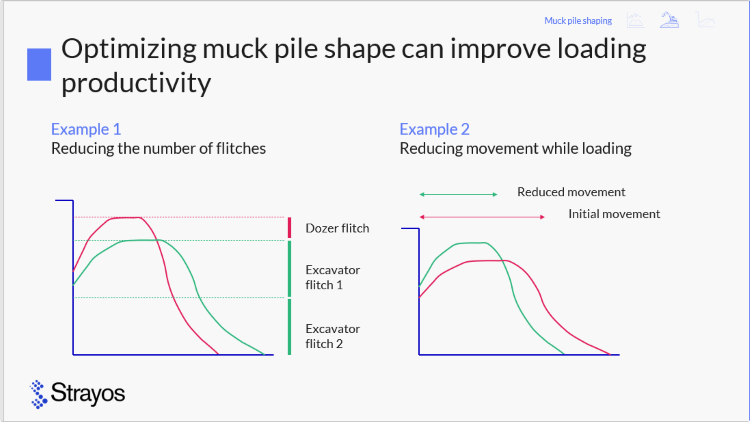
Muckpiles that are too high for the reach of your excavator require additional flitches or dozing it down to the size your excavators can handle. By being able to predict the muckpile shape and then adjust the blast design to get the proper shape for your muckpile you might be able to remove the need for the dozer entirely or reduce the total time of clearing the muckpile because the excavator doesnt need to spend the extra time on the additional pass on top of the pile. Alternatively, by getting a taller muckpile and reducing its footprint you could save time moving the excavator around less.
Drones and AI can now automate muckpile measurement and prediction

Drones can come in immediately image the muckpile. No need to slow down operations or put people in harms way. Automate the muckpile measurements including the boundaries, trough drop, center of mass movement, height, average throw, etc. No need for experts with specialized CAD software. Connect it to pre-blast data to generate insights and reports.
AI dramatically increases the speed of muckpile predictions. You can design a blast and immediately see the predicted shape. If it's not what you want you can go in and adjust the parameters and immediately see the new muckpile. The more you calibrate the AI with the pre-blast design and the actual resultant muckpile measurements- the more better the AI gets at predicting the next one.
Cast Optimization
Cast optimization is particularly important for surface coal mining and is the best way to reduce strip mining costs
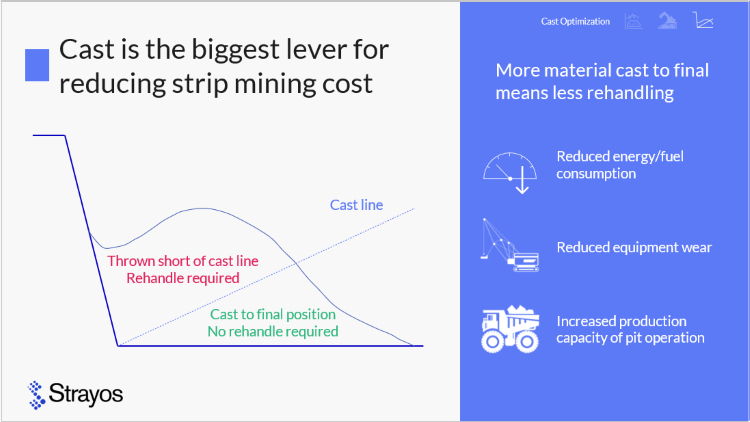
The cast line equals your doser push angle would be or traditionally just the angle of repose for your rock. Any rock under the cast line is finished no additional work is required, anything above the cast line means it will need to be moved. Any rock that requires rehandling drives up costs- additional time, fuel, wear and tear, and decreased pit production while you wait for the material to be moved. Cast optimization reduces all of these costs to save operations money.
Two key cast metrics to measure
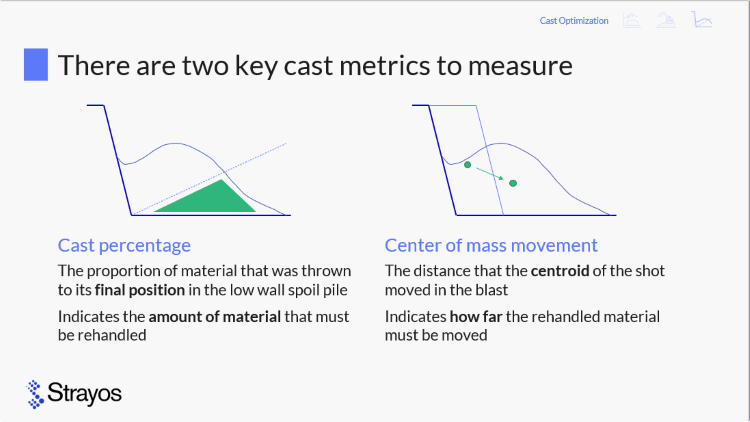
Cast Percentage- the Proportion of material that was thrown to its final position in the low wall spoil pile. Indicates the amount of material that must be rehandled.
Center of Mass Movement- the distance that the centroid of the shot moved in the blast. Indicates how far all material has been moved. Really difficult to do by hand in abnormal shapes, very time consuming and need a level of expertise to accomplish.
How to run cast optimization

Prepare- agree on a plan with the blast crew, engineers, and production management to make sure everyone is onboard with the new plan.
Baselining- The most important step. Need to establish a baseline for your site/operations. You can't measure what you don't know. If you make assumptions the results going forward won't be accurate. So fly the drone over the pre-blast and post-blast bench for 5+ baseline shots. You need data so that the AI is calibrated and so that you understand what is already happening. You Need to have your KPIs set in advance so you know how they are vs. what you're going to do in the future. You need to make sure the models are geo-referenced with an RTK or PPK drone or a GPS unit. Without the geo-referencing it will screw the models and give you inaccurate results.
Adjusting- Align on the target cast profile with the engineers and production management. Consider a variety of factors when shooting. There are situations when you won't get an efficient cast- if there's a dragline pad you don't want to cover up with rock or if there's a bunch of coal excavated and you don't want to cast the panel as much and cover up the coal.
Test variables one at a in the prediction module. And adjust the blast design. Need to adjust parameters individually not all 17 at once or else you won't know which adjustment caused the improvement. Maybe start with pattern change, maybe test loading change, etc...
Measure- Fly the drone before and after every shot and track performance. Once you have optimized one of the variables go back and adjust another variable then measure again.
Before I had to do it all manually and spent hours on it. Now the analysis and reporting are automated.
Real world example
Here's a cast operation I was actually involved with. Here's your cast optimization prediction. The Model predicted 3% more cast after making design changes. Here's the 3D model of the actual cast panel with the drill holes, the bench bottom, the drill holes, the blue line represents the muckpile shape, the yellow plane for the cast and where they intersect.
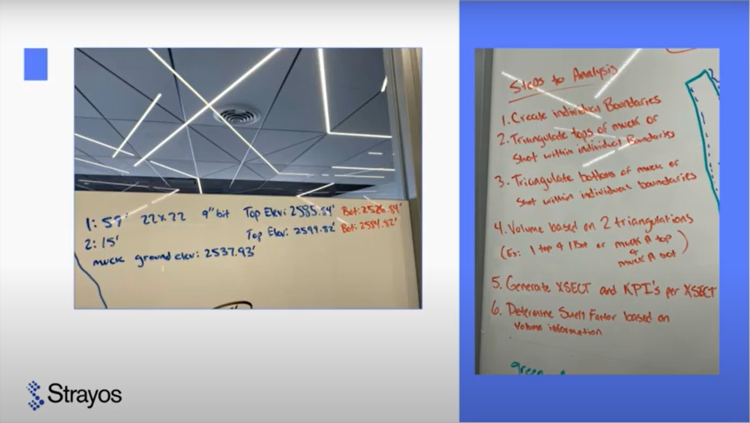
Here's the proof of the reality of the information and manual calculations. I knew the pattern, a 9 inch bit, the top and bottom elevation of the bench was 59 foot, and the ground elevation. That allowed me to triangulate the bench and the muckpile to the ground.
The steps to analysis that I was doing was creating the individual boundaries around the muckpile and bench, triangulating the tops of the shot with the individual bottom areas in those boundaries, triangulating the bottoms within the boundaries, determining the volume based on the triangulations so your muckpile to your bench. Generating your cross section and KPIs per cross section. I was doing it based on cross sections because I didn't have an automated 3D model, I was doing it all in autocad. Then determining the swell factor based on the volume information, basically the pre blast and post blast volume. The muckpile over bench.
This has now been automated.
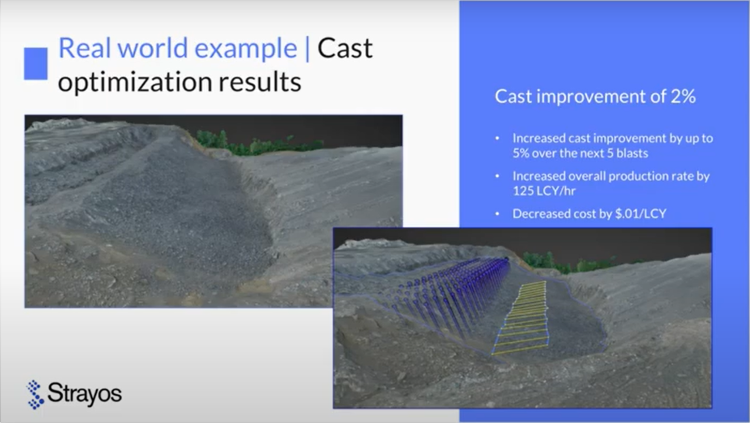
Heres what the actual post blast looked like for the cast analysis. Now you can see where the drill holes were in relation to what we did. Now you can see the actual cast line, theres no blue overlay for the predicted muckpile since we have a real muckpile now. There was a cast improvement of 2%. This number is based on real data- not a prediction.
What does a cast improvement of 2% actually mean? Over the next 5 blasts we increased the cast improvement by up to 5%. We increased the overall production rate by 125 Loose Cubic Yard (LCY)/hour and decreased cost by $.01/LCY. We measure waste in volume. Decreasing costs by $.01/ LCY is alot of money. Even if it were $.0001/LCY that is still alot of savings when you are moving lots and lots of rock.
Thank You
The manual process of taking all of those measurements individually and using autocad to do all the cross sections and calculations is something that has now been automated using AI tools and Drone models. These days you can get the same results and all of those costs savings without the investment of time that it took in the past.
What are some other metrics you use to measure blast performance? Or other metrics that you would like to measure?
- Backbreak
- Dig rates
- spillage
- throw
- drop
- segregation of materials (ore/waste)
- flyrock distance
- diggability
Q & A
Unfortunately we ran out of time before we were able to answer everyone's questions. So, as promised, here are the answer to the questions asked during the webinar...
1. Are you including any of the drill hole parameter recorders and technology in your step to mine to mill plan?
Yes, we already support direct integration with Epiroc and Sandvik smart drills as well as 3rd party measure while drilling logging technologies. Alongwith drill hole parameters post-drilling measurement devices such as boretrack units can also be easily incorporated and visualized in Strayos. The data from these systems can directly feed into mine to mill optimization.
2. Can Strayos support the Trinity F90+ drone data for all types of output generation?
Strayos is compatible with all types of drones and camera sensors. The minimum requirement for uploading pictures to Strayos is having photos that are geotagged so even your iPhone pictures can be uploaded. Strayos generates all types of photogrammetric outputs from georeferenced orthophoto, point cloud , 3D model OBJ etc.
3. With Orica, we are using the blast design software but I have not seen them using any post blast fragmentation analysis software. Is such integration possible.
Yes, Integration is possible. You can export your design from SHOTPlus as a csv and upload it into Strayos when you conduct the post-blast fragmentation analysis
4. A camera or scanner mounted on shovel can also do fragmentation analysis. It can measure boulder generated much more efficiently as it deals with the entire muck pile in a matter of few shifts. The drone camera on the other hand gives a static picture. How do you compare the 2 options.
Equipment mounted cameras are a great way to get a continual measurement of fragmentation throughout the muckpile. This data can be combined with a drone model to provide a full picture of fragmentation.
5. How much data is required to enable your AI models to produce accurate results/predictions?
Most of the AI models in Strayos such as Rock Mass Characterization and Fragmentation Detection are pre-trained so they provide accurate results from day 1. For Prediction models like Muckpile Profile and Fragmentation, we recommend using 3-5 blasts to calibrate the parameters.
6. Does Strayos offer post-blast analysis as an individual service? In the instance of just sending post-blast photos in for particle-size distributions?
Strayos does offer our products in separate modules so it is possible to just subscribe to the fragmentation module (along with the Strayos image processing platform).
7. We are compared in fragmentation analysis using manual serving and image processing technique they result accuracy is about 30 to 40 in image processing. Used in rip rap for break water project, Can you please quote your software accuracy
Strayos can detect particle size up to 6mm.The accuracy of the fragmentation analysis is dependent on the resolution, quality and altitude of the input images. In general our algorithm will detect rock sizes down to a few pixels across.
8. what could be the percentage of rising in the cost parameters of the blasting when you are using drones for every post-blast observation in the quarry blasting?
Most of the customers who have adopted drones for quarry blasting have seen decreases in overall costs as they are saving on load/haul and crusher throughput increase. The cost simply includes the cost of the drone and the cost of the fragmentation software.
9. Which model your using to predict the muckpile and fragmentation. Can we customize the model or can we change the model as per my requirement
We have developed a proprietary machine learning algorithm which calibrates to the specific site. It combines variety of parameters from blast design, geology and in-situ block to predict the fragmentation and muckpile.
Yes, the models in Strayos can be customized to adapt to your site requirements.
10. What are the variables that are considered as part of the muckpile predictions? Does it include hole loads, product type, and timing?
Yes, it considers geological rock properties as well as blast design parameters like powder factor and timing including the features of the interaction of various properties of rock-mass and explosives materials, local geology, the initial distribution of explosive mass etc
11. Is there a possibility to test your software? Especially fragmentation and prediction module?
Yes, we offer a 30-day free trial period for testing the software.
12. Whether do you have any demo free version software for fragmentation analysis?
Yes, we offer a 30-day free trial period for testing the software.
13. How accurate the software to convert drone data into survey data? Have you been compare before with conventional tools
Yes, we have collaborated with multiple universities and customers to validate the accuracy of our survey models. Strayos photogrammetry engine is compared with other softwares and laser scanners method. Please reach out to us directly if you would like an access to the accuracy comparision whitepapers. We are fully compatible with RTK and PPK drone data as well as Ground Control Point data allowing users to create survey grade models.
14. We used drone and [a different company's fragmentation software] for grading the Armour stone >6MT (2cum) size but result is not up to the mark. Can spell out few light on these with your product. (Individual spreaded boulder (Armour stone)
We would be happy to process your existing drone images and demonstrate the results from our product. Please reach out to us through the website or over email to get in touch.
15. Whats your experience on the predictions with Strayos Vs. actual measurements?
Muckpile predictions are made using a combination of classic geophysical models and artificial intelligence. In our experience they are very accurate once calibrated to the geological conditions of the site.
16. A question about atmospheric monitoring. I presume you fly the drone to capture the actual blast. Does this allow analysis using your AI to improve the face velocity of future blasts and hence also overpressure from the blast. Does it also allow analysis of post blast fume and concentrations associated with the fume generation.
Blast video analysis for face velocity and fume measurement is currently in the prototype phase of our roadmap. We would love to work with you to develop these tools further so please feel free to get in touch at hello@strayos.com.
Presenters Bio!
Jon Lewis

Jon is a graduate from the University of Kentucky Mining Engineering program. Upon graduation he worked for the explosive manufacturer Nelson Brothers where he primarily focused on project management and blasting optimization for coal mines and quarries. These projects ranged from bucket fill optimization to cast blast analysis. He is now the Senior Manager of Drilling and Blasting for a metallurgical coal company.
Brad Gyngell

Brad helps mining companies maximize the value of their operations. He spent the first phase of his career helping over 100 sites optimize drill and blast activities as a mining engineer with the world's leading explosives providers Orica and Dyno Nobel. He then expanded the scope of his support to encompass all commercial and operational functions by moving into management consulting with the top tier firm Boston Consulting Group. As COO of Strayos, Brad leads the development of AI solutions that combine visual and operational data sources to solve tangible use cases for mine operators. Brad holds a B Eng (Mining Engineering) from UNSW and an MBA (Finance, Entrepreneurship) from Carnegie Mellon University.

New technologies are rapidly changing the drilling, blasting, mining, and aggregates industries, empowering them in ways never before possible. Make sure you are taking advantage of the best tools available.
Check out our 2 Free E-books on AI applications for the drilling, blasting, and mining industries to see all the amazing advances that are available.
AI Guide for Drilling and Blasting
AI Guide for Mining
TLDR? Watch our videos instead:
YouTube
